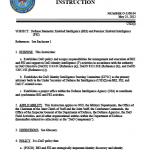
BEI and FEI are strategically important identity discovery and identity resolution intelligence processes used to unambiguously identify persons, networks, and populations of interest who pose potential threats to U.S. forces and national security.
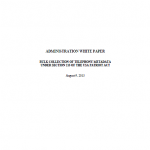
This white paper explains the Government’s legal basis for an intelligence collection program under which the Federal Bureau of Investigation (FBI) obtains court orders directing certain telecommunications service providers to produce telephony metadata in bulk. The bulk metadata is stored, queried and analyzed by the National Security Agency (NSA) for counterterrorism purposes. The Foreign Intelligence Surveillance Court (“the FISC” or “the Court”) authorizes this program under the “business records” provision of the Foreign Intelligence Surveillance Act (FISA), 50 U.S.C. § 1861, enacted as section 215 of the USA PATRIOT Act (Section 215). The Court first authorized the program in 2006, and it has since been renewed thirty-four times under orders issued by fourteen different FISC judges. This paper explains why the telephony metadata collection program, subject to the restrictions imposed by the Court, is consistent with the Constitution and the standards set forth by Congress in Section 215. Because aspects of this program remain classified, there are limits to what can be said publicly about the facts underlying its legal authorization. This paper is an effort to provide as much information as possible to the public concerning the legal authority for this program, consistent with the need to protect national security, including intelligence sources and methods. While this paper summarizes the legal basis for the program, it is not intended to be an exhaustive analysis of the program or the legal arguments or authorities in support of it.
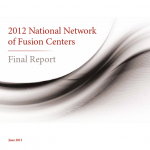
In 2011, the U.S. Department of Homeland Security’s (DHS) Office of Intelligence and Analysis (I&A), in coordination with federal and SLTT partners, began conducting an annual assessment of fusion centers to evaluate their progress in achieving the COCs and ECs and to collect additional data to better understand the characteristics of individual fusion centers and the National Network as a whole. DHS/I&A initiated the 2012 Fusion Center Assessment (2012 Assessment) in August 2012 as the second iteration of the annual assessment process and the first assessment to provide data on year-over-year progress in implementing the COCs and ECs. The 2012 Assessment was also the first assessment to collect National Network performance data based on an initial set of five performance measures adopted in 2011. This 2012 National Network of Fusion Centers Final Report (2012 Final Report) summarizes and characterizes the overall capabilities and performance of the National Network based on the results of the 2012 Assessment. This report does not include fusion center-specific capability or performance data. Instead, it uses aggregated data from the 2012 Assessment to describe the capability and performance achievements of the National Network.

In a restricted report issued in May, the DEA detailed the most recent findings from its heroin monitoring program, assessing the period from 2006 -2011. The report finds that heroin in the U.S. generally comes from two different places: South America and Mexico. If you live east of the Mississippi River, chances are that the heroin you’re buying is from South America. Heroin purchased on the West Coast is almost certainly trafficked from Mexico. Some heroin from Southwest Asia does make it to the U.S. However, the amount is minimal compared to other sources and the quality is relatively poor.

This report presents data and conclusions from the Heroin Domestic Monitor Program (HDMP) conducted by the Drug Enforcement Administration (DEA) for calendar year (CY) 2011. The HDMP provides data on the price, purity, and geographic source of heroin sold at the retail level in 27 U.S. cities. The data contained in this report are based on actual undercover heroin purchases made by the DEA and its law enforcement partners on the streets of these cities.
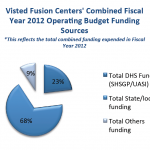
During the 112th Congress, then-Committee on Homeland Security (Committee) Chairman Peter T. King, currently the Chairman of the Subcommittee on Counterterrorism and Intelligence, directed Committee Majority staff to conduct a comprehensive study of the National Network in an effort to understand current strengths and gaps and provide recommendations for improvement. This work continued into the 113th Congress under the additional direction of current Committee Chairman Michael T. McCaul. Over the course of nineteen months (January 2012-July 2013), the Committee logged 147 meeting hours during visits to 32 fusion centers, in addition to numerous briefings and discussions with various Federal partners, representatives of the National Fusion Center Association, and follow-up conversations with fusion center directors and personnel.
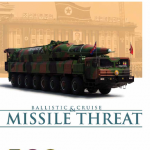
Many countries view ballistic and cruise missile systems as cost-effective weapons and symbols of national power. In addition, they present an asymmetric threat to US airpower. Many ballistic and cruise missiles are armed with weapons of mass destruction. Ballistic and cruise missiles present a significant threat to US and Allied forces overseas, and to the United States and its territories. Missiles are attractive to many nations because they can be used effectively against an adversary with a formidable air defense system, where an attack with manned aircraft would be impractical or too costly. In addition, missiles can be used as a deterrent or an instrument of coercion. Missiles also have the advantage of fewer maintenance, training, and logistic requirements than manned aircraft. Even limited use of these weapons could have devastating consequences because missiles can be armed with chemical, biological, or nuclear warheads.
A table describing Research in Motion/Blackberry requirements for disclosure of user data to law enforcement. The chart shows what legal process is required to request user data, the type of data each process can typically obtain and the legal authorities authorizing each form of request.
A collection of Network Security Agreements (NSAs) entered into with foreign communications infrastructure providers ensuring U.S. government agencies the ability to access communications data when legally requested. The agreements range in date from 1999 to 2011 and involve a rotating group of government agencies including the Federal Bureau of Investigation (FBI), Department of Homeland Security (DHS), Department of Justice (DoJ), Department of Defense (DoD) and sometimes the Department of the Treasury. According to the Washington Post, the agreements require companies to maintain what amounts to an “internal corporate cell of American citizens with government clearances” ensuring that “when U.S. government agencies seek access to the massive amounts of data flowing through their networks, the companies have systems in place to provide it securely.”
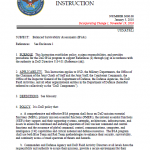
Multidisciplinary, integrated, performance-based, mission survivability assessments to identify and quantify vulnerabilities in systems, networks, architectures, infrastructures, and assets that support DoD MEFs, PMEFs, or the NEFs they support, to assess the mission impact if the vulnerabilities were successfully exploited, and to recommend measures to remediate or mitigate the vulnerabilities.

Fireworks are a common component used in Improvised Explosive Devices (IEDs). The US Government is asking consumer fireworks retailers to be aware of this phenomenon and familiarize themselves with some possible indicators of suspicious activity. This list is not inclusive, nor is it intended to limit the lawful conduct of innocent persons. The totality of behavioral indicators and other relevant circumstances should be considered.
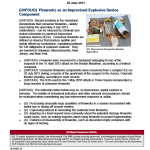
Recent incidents in the Homeland demonstrate that consumer fireworks—widely used during the upcoming 4 July 2013 celebrations—can be misused by criminals and violent extremists to construct improvised explosive devices (IEDs). Consumer fireworks are defined as devices that produce audible and visible effects by combustion, containing between 50-130 milligrams of explosive material. They are banned in Delaware, Massachusetts, New Jersey, and New York.
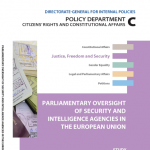
This study evaluates the oversight of national security and intelligence agencies by parliaments and specialised non-parliamentary oversight bodies, with a view to identifying good practices that can inform the European Parliament’s approach to strengthening the oversight of Europol, Eurojust, Frontex and, to a lesser extent, Sitcen. The study puts forward a series of detailed recommendations (including in the field of access to classified information) that are formulated on the basis of in-depth assessments of: (1) the current functions and powers of these four bodies; (2) existing arrangements for the oversight of these bodies by the European Parliament, the Joint Supervisory Bodies and national parliaments; and (3) the legal and institutional frameworks for parliamentary and specialised oversight of security and intelligence agencies in EU Member States and other major democracies.